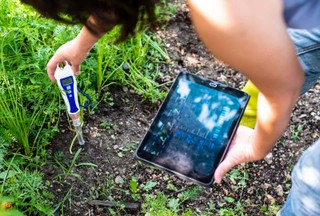How to test the pH of soil in 4 ways

Successfully growing plants, especially edible produce, in your garden takes hard work and a good understanding of the growing conditions your plants need. It’s a little bit of science and a little bit of art all rolled into one. One of the biggest science components is related to soil pH and making sure your soil is in the proper range. Don’t worry though, once you have a general understanding you’ll be well on your way to testing the pH of your garden soil and keeping it where it needs to be!
So, the soil nerd in me - who was one class shy of a chemistry minor - is going to try to walk you through the basics of soil pH in a way that’s easy to understand: what it is, why it’s important, what impacts the pH level of your soil, and how to determine your soil’s pH.
What is soil pH?
Soil pH is a measurement of how acidic or basic (also known as alkaline) the soil is, like the acidity we are familiar with regarding liquids.
pH - the potential of hydrogen - measures the concentration of hydrogen ions, both positively charged hydrogen ions (H+) and negatively charged hydroxyl ions (OH-) in an environment. More positively charged hydrogen ions creates an acidic environment; a greater amount of negatively charged hydroxyl ions produces an environment that is less acidic, or basic.
The acidity or alkalinity of something is measured on a logarithmic scale ranging from 0 - 14. Values increase or decrease by a factor of ten when there is a change in one full numerical unit. This means that a soil with a pH of 5 is ten times more acidic than one that has a pH of 6, even though the value only changed by one.
Values on the pH scale are broken down to distinguish the relative acidity or alkalinity:
- 0 - 2 is strongly acidic.
- 3 - 5 is weakly acidic.
- 6 - 8 is considered neutral.
- 9 - 11 is weakly basic.
- 12 - 14 is strongly basic.

Why is it important to know your soil pH?
Knowing your soil’s pH gives you a better understanding of how the nutrients in the soil, i.e. what your plants use for “food”, react based upon the soil conditions.
Nutrient availability is highly influenced by soil pH. If the pH of the soil is too far from neutral, so if it is either too acidic or too alkaline, it significantly influences how much of a given nutrient is available for the plants to take into their roots for use. Different nutrients become unavailable for plant uptake, or insoluble, at different pH values.
At both the low and high end of the pH scale the plant essential macronutrients – those needed in larger amounts for plant metabolic processes such as nitrogen, phosphorus, potassium, calcium, magnesium, and sulfur– become tied up, making them difficult for the plant to absorb; the micronutrients (chlorine, iron, boron, manganese, zinc, copper, molybdenum, and nickel) needed for plant functions become more available at these extremes, potentially becoming toxic to plants due to their abundance. When the soil pH levels are at or below 5,[1] aluminum changes to an ion that is very soluble in the soil, creating aluminum toxicity in plants.
Optimum soil pH
Ideally, you want your garden soil to have a neutral pH or even a touch on the acidic side. Most plants prefer a soil pH between 6.0 and 7.5. This range provides the best nutrient availability.
Some plants like azaleas and blueberries need a more acidic environment, but that’s a whole other topic.

The enthusiast's guide to herbs
We’re proud to present our new e-book, The Enthusiast’s Guide to Herbs! Learn everything you need to know about growing and caring for herbs indoors, including in-depth info cards for the 35 most commonly grown herbs.
Click the link below to find out more!
What impacts soil pH?
There are many factors involved in soil chemistry that impact a soil’s pH level.
Parent material
Soil forms by the slow weathering process of parent materials found deeper under the earth’s surface. The rocks that come from the underground layers of bedrock vary in composition from very acidic to very alkaline. As they break down, the soil is formed.
Acidic soils are formed from sandstone or shale. Alkaline soils are formed from limestone.
Precipitation levels
Acid soils are most often found in areas of high rainfall. Rainwater is slightly acidic (pH is usually about 5.7) due to a reaction with carbon dioxide in the atmosphere that forms carbonic acid. When it percolates down through the soil it leaches cations and bicarbonates, increasing the concentration of H+ relative to other cations.
Alkaline soil is most often found in areas with arid climates. Areas with less rainfall do not experience the cation and bicarbonate leaching from the soil profile, maintaining a lower concentration of hydrogen ions.
Plant growth and nutrient uptake
Plants are constantly taking nutrients from the soil, pulling them into their roots to meet their nutritional and metabolic needs. They often take up more cations (molecules with a positive charge) than ions. To maintain a neutral balance inside the cells of the roots they exude H+ ions back into the soil, acidifying the area right around the roots.
Fertilizer applications
Nitrogen-based fertilizers are one of the biggest culprits of pH change in cultivated soils. Ammonium fertilizers (NH4+) undergo a process known as nitrification in the soil, to create nitrate (NO3-) the plants can use. A by-product of nitrification is H+ ions, which increases soil acidity.
Irrigation water quality
While natural rainfall will result in an increase in soil acidity, the use of irrigation water has the opposite effect, creating alkaline soil conditions. High levels of dissolved calcium and magnesium are frequently found in irrigation waters as both carbonates and bicarbonates.
When irrigation water is applied to arid soils (that may already have a higher than neutral pH), the bicarbonates react with H+ in the soil lowering their concentration and further increasing the soil pH. The calcium or magnesium carbonates can precipitate out of the irrigation waters as lime, increasing the soil pH even further.
Acid rain
Normal rainfall is slightly acidic, acid rain, on the other hand, has added sulfuric and nitric acid in it from the burning of fossil fuels. Areas with acid rain will see a further decrease in soil pH as sulfuric and nitric acid reacts with bicarbonates in the soil to increase the concentration of H+.

How to amend soil pH
To change the pH of your soil, you will need to add soil amendments to alter the soil chemistry and change the concentration of positively charged hydrogen ions (H+) and negatively charged hydroxyl ions (OH-) it contains.
- Highly acid soils need a reduction in H+ to bring them into a better ph range. Liming materials are oxides, hydroxides, carbonates, and silicates of calcium and/or magnesium with calcium carbonate being the standard for liming materials. The anions, or negatively charged particles in the lime, react with the free hydrogen ions to lower the acidity and raise the pH level.
- Alkaline conditions need an increase in the concentration of hydrogen ions. To adjust the pH levels of an alkaline soil soil-acidifying products such as peat moss, elemental sulfur, or pine needles are added. Peat moss is a good option when working with a smaller garden plot; elemental sulfur in a granular form is the most cost-efficient way, albeit slowest, to raise the soil pH of a large area.
- To maintain a neutral pH, or make small changes in the soil pH add finished compost that is high in organic matter.
How to test the pH of soil
The pH level of your soil can and does, change over time because of the factors I talked about above. This is why it’s important to regularly take a representative soil sample from your garden and perform a pH test.
First, let’s talk about how to correctly take a soil sample, then we can talk about the various pH testing methods.
Collecting a soil sample
Collecting a soil sample is quite simple using the following steps. This way of collecting a soil sample is appropriate to use for all of the soil pH testing methods.
All you need is a clean bucket, a small garden trowel, and some newspapers.
- Collect small shovelfuls of soil from 12-15 different parts of your garden to a depth of 6 to 10-inches, putting them in the bucket after you dig them. Avoid any areas that are considerably different such as spots that collect water, sandy spots, etc.
- Mix the soil together well, removing any rocks, twigs, or other foreign debris.
- (Optional depending on the pH testing method.) Spread the collected, mixed soil out on newspaper in a thin layer, allowing it to air dry at least overnight. Do not put it in the oven or microwave to dry it.
Soil pH testing methods
Now that you have a sample collected, you can choose which method to use to get pH measurements. There are a handful of ways to test the pH of your soil, ranging in accuracy and price, giving you a variety of options for testing.
1. Professional soil test
The simplest and most accurate way to check soil pH is to have it done by a professional, commercial soil testing laboratory. Prices usually cost $7-10 per sample, and the test results are typically accompanied by a lime recommendation if you have acidic soil.
You simply need to collect a soil sample, allow it to air dry, and then send about one cup of soil into the lab packaging it up per the lab’s directions.
2. DIY method without a kit
If you only want a general idea if your soil is acidic, neutral, or alkaline you can perform a test using some basic kitchen ingredients. You’ll need a glass bowl, a spoon, some distilled water, baking soda, and vinegar. Do not use tap water, bottled water, or rainwater; tap water or bottled water tends to be slightly alkaline, while rainwater is slightly acidic and will affect your results.
- Place about one cup of soil in the bowl and add enough distilled water to turn it into mud.
- Add ½ cup of vinegar to the mud mixture and stir gently. If it begins to bubble or fizzes your soil is alkaline. If nothing occurs your soil is neutral or acidic and you should repeat the process.
- Make another mud mixture and add ½ cup of baking soda, mixing slightly. If it begins to bubble or fizz your soil is acidic. If nothing occurs your soil has a neutral pH.
3. pH strips
Using pH test strips to test your soil sample will give you a more accurate measurement than the DIY method but the dependability of results is based upon how well you can read the litmus paper and the testing kit will only give you a range of values, not a specific number.
For this method, you will need a soil test kit from an online retailer or your local garden center, a glass bowl, a spoon, and some distilled water. Again, do not use tap water, bottled water, or rainwater for the reasons mentioned above.
- Place about one cup of soil in the bowl and add enough room-temperature distilled water to create the consistency of a milkshake.
- Remove a test strip from the container, holding it by the non-reading end, dip the strip into the mud mixture for 20-30 seconds (or longer if your directions instruct you to do so).
- Dip the test strip quickly in clean distilled water to remove all soil residue.
- Compare the developed color on the end of the test strip to the color chart on the manufacturer’s packaging to determine the approximate pH.

4. pH meters
Testing the soil pH using a pH testing meter is the most dependable, accurate method of testing your soil pH yourself. But it has the greatest one-time cost to purchase the ph meter, however, if taken care of properly it will last a long time.
For this method, you’ll need a glass container, a spoon, distilled water, and your pH meter.
- Place equal amounts of dry soil and distilled water in the glass container.
- Stir the soil/water mixture for 5-10 seconds, and then let sit for 15 minutes undisturbed.
- Stir the soil again for another 5-10 seconds, then take your reading following the manufacturer’s directions.
Soil pH meters
If you are interested in purchasing a soil pH meter, to accurately test your soil pH yourself, you want to make sure you purchase a high-quality, reliable product.
The retail market is flooded with pH meters ranging in value from a few dollars up to hundreds of dollars. Choosing the best one for at home soil testing can be daunting, that’s for sure. The following pH meter is my recommendation for use at home.
Best overall handheld pH meter
The Bluelab Soil pH Pen measure both soil pH and temperature, providing quick and accurate results when measuring the pH of both soil slurries and liquid solutions. No more fiddling with pH strips or sending soils off to a lab to be tested.
Featuring an easy to read, backlit display, the soil pH pen has a hold and auto-off function as well as a low battery warning. It is fully waterproof and works in conditions from 32 °F to 122 °F; allowing you to check your pH in almost any weather condition.
It comes with easy to follow instructions, detailing how to use this handheld probe with step by step directions on calibration and cleaning.
Who should purchase this?
This pH meter is the perfect investment for gardeners looking to dial in their hobby and perfect their veggie growing. Having an accurate measurement of your soil pH allows you to ensure optimal nutrient availability with no worry of aluminum toxicity.
Pros:
- Provides accurate readings in soil or liquid solutions.
- Measures in 0.1 pH units.
- User guide provides clear, intuitive instructions
Cons:
- Probe has to be kept wet when stored.
- Requires a 2-point calibration to ensure accuracy.
We now recommend the Bluelab PENGTB Growers Toolbox which includes the Soil pH Pen plus a grow book and Conductivity Probe care kit. See photos and purchase the Bluelab Growers Toolbox at Amazon.
Conclusion
Knowing your soil’s pH is an invaluable tool when gardening. Maintaining a soil pH between 6.0 and 7.5 ensures optimal nutrient availability for your plants, and in turn, no deficiency problems or toxicity symptoms. Soil pH is easy to measure through a handful of different methods making it a cinch to take your gardening to the next level, resulting in stronger, healthier plants, and a more bountiful yield.

Join our email club—get printable info cards free!
Sign up to receive our newsletter and get access to 10 printable plant info cards from our e-book for free. Also receive:
- $4 discount code for our Guide to Herbs e-book
- Semi-weekly plant inspiration & bite-size tips and tricks
Zheng S. J. (2010). Crop production on acidic soils: overcoming aluminum toxicity and phosphorus deficiency. Annals of botany, 106(1), 183–184. doi:10.1093/aob/mcq134 ↩︎
